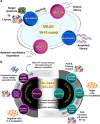Aptamer-nanoparticle complexes as powerful diagnostic and therapeutic tools
- PMID: 27151454
- PMCID: PMC4910152
- DOI: 10.1038/emm.2016.44
Aptamer-nanoparticle complexes as powerful diagnostic and therapeutic tools
Abstract
Correct diagnosis and successful therapy are extremely important to enjoy a healthy life when suffering from a disease. To achieve these aims, various cutting-edge technologies have been designed and fabricated to diagnose and treat specific diseases. Among these technologies, aptamer-nanomaterial hybrids have received considerable attention from scientists and doctors because they have numerous advantages over other methods, such as good biocompatibility, low immunogenicity and controllable selectivity. In particular, aptamers, oligonucleic acids or peptides that bind to a specific target molecule, are regarded as outstanding biomolecules. In this review, several screening techniques for aptamers, also called systematic evolution of ligands by exponential enrichment (SELEX) methods, are introduced, and diagnostic and therapeutic aptamer applications are also presented. Furthermore, we describe diverse aptamer-nanomaterial conjugate designs and their applications for diagnosis and therapy.
Figures






Similar articles
-
Recent Advances in SELEX Technology and Aptamer Applications in Biomedicine.Int J Mol Sci. 2017 Oct 14;18(10):2142. doi: 10.3390/ijms18102142. Int J Mol Sci. 2017. PMID: 29036890 Free PMC article. Review.
-
Generating aptamers by cell-SELEX for applications in molecular medicine.Int J Mol Sci. 2012;13(3):3341-3353. doi: 10.3390/ijms13033341. Epub 2012 Mar 12. Int J Mol Sci. 2012. PMID: 22489154 Free PMC article. Review.
-
Development of DNA aptamers specific for small therapeutic peptides using a modified SELEX method.J Microbiol. 2022 Jul;60(7):659-667. doi: 10.1007/s12275-022-2235-4. Epub 2022 Jun 22. J Microbiol. 2022. PMID: 35731347
-
Advances of aptamers screened by Cell-SELEX in selection procedure, cancer diagnostics and therapeutics.Anal Biochem. 2020 Jun 1;598:113620. doi: 10.1016/j.ab.2020.113620. Epub 2020 Feb 19. Anal Biochem. 2020. PMID: 32087127 Review.
-
Trends in aptamer selection methods and applications.Analyst. 2015 Aug 21;140(16):5379-99. doi: 10.1039/c5an00954e. Analyst. 2015. PMID: 26114391 Review.
Cited by
-
Nucleic Acid Aptamer: A Novel Potential Diagnostic and Therapeutic Tool for Leukemia.Onco Targets Ther. 2019 Dec 4;12:10597-10613. doi: 10.2147/OTT.S223946. eCollection 2019. Onco Targets Ther. 2019. PMID: 31824168 Free PMC article. Review.
-
Aptamer selection and applications for breast cancer diagnostics and therapy.J Nanobiotechnology. 2017 Nov 13;15(1):81. doi: 10.1186/s12951-017-0311-4. J Nanobiotechnology. 2017. PMID: 29132385 Free PMC article. Review.
-
Nanomedicine in Cancer Therapeutics: Current Perspectives from Bench to Bedside.Mol Cancer. 2025 Jun 9;24(1):169. doi: 10.1186/s12943-025-02368-w. Mol Cancer. 2025. PMID: 40490771 Free PMC article. Review.
-
Advances in Gold Nanoparticle-Based Combined Cancer Therapy.Nanomaterials (Basel). 2020 Aug 26;10(9):1671. doi: 10.3390/nano10091671. Nanomaterials (Basel). 2020. PMID: 32858957 Free PMC article. Review.
-
Combination Chemotherapy of Lung Cancer - Co-Delivery of Docetaxel Prodrug and Cisplatin Using Aptamer-Decorated Lipid-Polymer Hybrid Nanoparticles.Drug Des Devel Ther. 2020 Jun 9;14:2249-2261. doi: 10.2147/DDDT.S246574. eCollection 2020. Drug Des Devel Ther. 2020. PMID: 32606595 Free PMC article.
References
-
- Nimjee SM, Rusconi CP, Sullenger BA. Aptamers: an emerging class of therapeutics. Annu Rev Med 2005; 56: 555–583. - PubMed
-
- Jayasena SD. Aptamers: an emerging class of molecules that rival antibodies in diagnostics. Clin Chem 1999; 45: 1628–1650. - PubMed
-
- Proske D, Blank M, Buhmann R, Resch A. Aptamers—basic research, drug development, and clinical applications. Appl Microbiol Biotechnol 2005; 69: 367–374. - PubMed
-
- Banerjee S, Wong SS. Synthesis and characterization of carbon nanotube-nanocrystal heterostructures. Nano Lett 2002; 2: 195–200.
Publication types
MeSH terms
Substances
LinkOut - more resources
Full Text Sources
Other Literature Sources

